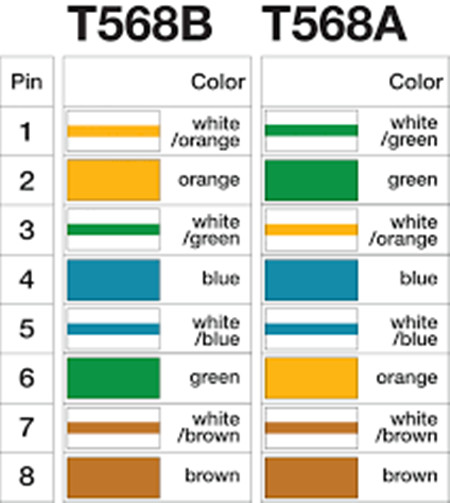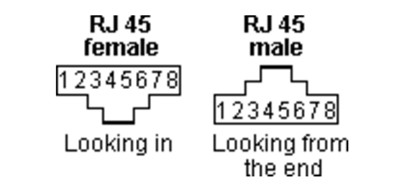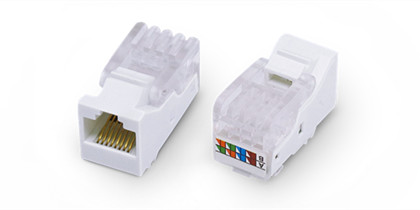Many people think that RJ45 to RJ45 connectors are the same as the modular plugs or jacks, but they’re wrong. In most cases, the term plug technically refers to the cable or male end of the connection while the term jack refers to the port or female end. If you have had a misunderstanding about these concept, you probably have experienced problems that were extremely difficult to resolve in your network. Therefore this article will have a brief introduction to the male and female RJ45 connectors.
RJ45 Pinout
RJ45 connector stands for registered jack 45, is most commonly seen with bulk Ethernet cables and network cables. This registered jack specifies the physical male and female connectors as well as the pin assignments. Before we start with the discussion of the male and female RJ45 connector for modular connectors, it is good to know how pins are numbered on RJ45 connectors.
Two standard RJ45 pinouts define the arrangement of the individual eight wires needed when attaching connectors to a cable—the T568A and T568B standards. Both follow a convention of coating individual wires in one of five colors—brown, green, orange, blue and white—with certain stripe and solid combinations.
Following these color scheme is essential when building cables to ensure electrical compatibility with other equipment. T568B has become the more popular standard. The table below summarizes this color coding.

RJ45 cables using RJ45 to RJ45 connectors and cat5/cat6 twisted pair cabling is easy to construct using the correct tools. In particular, RJ45 connectors and cabling standards are simplicity itself as RJ45 only uses four of the eight pins on the connectors. Pins 1 & 2 transmit data, whilst pins 3 & 6 are used to receive data when used in an Ethernet configured data port.
Male and Female RJ45 Connector
RJ45 connector as the modular connector, has gender: plugs are considered as male, while jacks or sockets are considered to be female. Modern Ethernet cables feature small plastic plugs on each end that are inserted into RJ45 jacks of Ethernet devices.
Plugs are used to terminate loose cables and cords, while jacks are used for fixed locations on surfaces such as walls and panels, and on equipment. Other than telephone extension cables, cables with a modular plug on one end and a jack on the other are rare. Instead, cables are connected using a male-to-male adapter, which consists of two female jacks wired back-to-back.

The scheme above shows the exact pin numbering on both male to male and RJ45 female to female connectors. All other modular jacks start counting at the same side of the connector. In the wiring diagrams with modular jacks on this site, we prefer to use a picture of the jack upside down, with the hook underneath.
Female Connector (Jacks) and Male RJ45 Connector (plugs)
Jacks and plugs have very similar packaging even though the functions that they perform are not similar at all. According to different applications, it comes in a wide range of different types from modular connectors and plugs (phone jacks, computer and Ethernet jacks etc.) to Internet connections and electronic components.
Telephone jack, or female to female RJ45 connector, is a very type of modular connector. This small unit is connected to a telephone cord which then transmits a telephone analog signal from a special phone outlet placed on a wall, desk or cubicle to the actual phone unit. An Ethernet jack looks much like a regular phone jack, but it is slightly wider. This port can be used to connect your computer to another computer, a local network, or an external DSL or cable modem. The following image shows the toolless cat5e Keystone Jack.

As noted before, male plugs are used to terminate loose cables while female jacks are used for fixed locations. In other words, appliances have cords ending in a male plug, which is fitted into the female outlet. FS.COM RJ45 modular plug use on solid or stranded conductor cat5e cable. These modular plugs are manufactured from polycarbonate to withstand everyday wear and tear, and the contacts are 50 micron gold for optimum signal transmission.
The Common Issue With RJ45 Connectors
A male connector or plugs can be inserted snugly into a receptacle ( female connector ) to ensure a reliable physical and electrical connection. Some RJ45 plugs utilize a small, bendable piece of plastic called a tab to help form a tight connection between a cable and a port on insertion. But it is also the problem of the connector when it snags on another cable. The locking tab is prone to breaking.
Here I’d like to list some tricks to avoid this: Buy the connectors with the locking tab curved down so it avoids the snagging. If you can’t find the cleverly designed connectors use boots to avoid snapping the tabs. Use a good quality crimping tool that doesn’t press on the tab when you crimp the connector.
All in all, crimping a RJ45 to RJ45 connector is not easy. The operation requires dexterity attention and training. If you want to make your life easier, you can use wire guides that come with some packages. Practice a lot and you won’t need the guides.

thanks for sharing,good blog..
ReplyDeletestructured cabling companies
structured cabling solutions